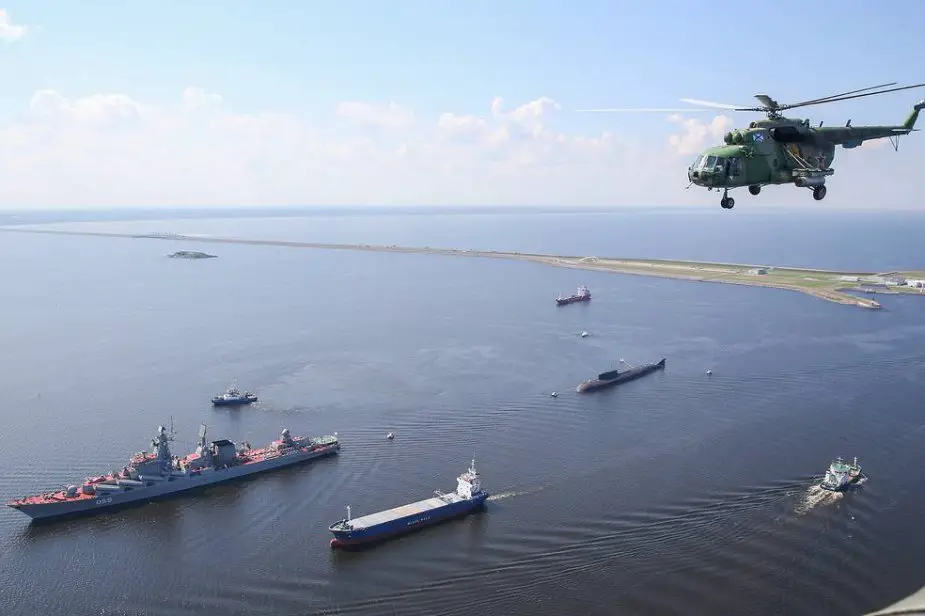Analysis: Russian Navy to focus on precision weapons - take 4
Russia is building new-generation warships and submarines and upgrading old ships. Design of next-generation warships and submarines is beginning. The Defense Ministry and industry have sustainable perceptions of the development of major classes of warships and auxiliary vessels, the Independent Military Review writes.
Follow Navy Recognition on Google News at this link
 Analysis: Russian Navy to focus on precision weapons - take 4 (Picture source: © Piotr Kovalev/TASS)
Analysis: Russian Navy to focus on precision weapons - take 4 (Picture source: © Piotr Kovalev/TASS)
Stealth and electronic warfare technologies have to increase combat sustainability of warships in a difficult tactical situation. The radar signature has to be decreased by a different configuration of above-water board, superstructure and masts, the placement of deck equipment and launchers inside the hull or behind the splash board, and a broad use of composite materials. The project is to drop the funnel which is the main thermal source to decrease infrared signature. The exhaust gasses will be cooled down to 60-80 degrees and discharged horizontally along the waterline.
Experts believe it is necessary to upgrade the power plant to decrease the physical fields. Electric motion systems integrated into a single electric power plant offer a promising guideline and can provide the required speed and power for various consumers. Increased specific capacity and decreased weight and size are to be provided by direct current engines, electric motor modules, and water jets. The creation of powerful magnets and bipolar transistors with an isolated breech prompted the design in the field. Issues of direct-current electric switchboard and its upgraded components (transformers, interrupters, etc.) are being considered. The integrated power plant has to power the direct-current electric engine by wires which considerably decreases acoustic noise due to the absence of mechanical connections between them.
The upgrade of gas turbines is to provide higher outgoing capacity, decrease consumption, weight and size. Western experts believe the optimal way is to use intermediate cooling and recuperation in gas turbines. Trials show that intermediate cooling and recuperation consume 30-40 percent less and yield 10-percent higher capacity with smaller weight and size.
Much attention has been paid to propulsion upgrade of late. Upgraded traditional multi-blade propellers have to use composite materials instead of bronze. The materials have a high specific rigidness, improve the weight and size of propellers, and decrease the noise due to high vibration-absorbing features of the blades. The technology produces practically identical propellers which decrease corrosion triggered by the contact of a steel hull and a bronze propeller.
However, the room for improvement of traditional propellers is not big. Western experts believe water jets will be used to provide good maneuverability, simple control and a high efficiency ratio at slow and full speed. Water jets with a capacity of over 40 thousand HP and a high efficiency ratio have been created already.
Operational costs can be decreased by reducing the crew due to automatic information collection, processing and decision-making in technical maintenance, operation and overhaul of systems, as well as warship control in various navigational and tactical conditions. The United States launched an R&D to design local distributed computer network with an open architecture and asynchronous data transmission which will unite automatic bridge subsystems, assess the state of warship systems and devices, promote survivability and power plant control, and regulate fuel consumption and warship communications. Data will be exchanged by optic fiber to ensure high jam-resistance and transmission speed.
US experts want to change the actions of the crew in combat and accident alerts and everyday activities and design new principles and software. Complex automation will decrease the workload to operate arms and hardware 40-50 percent.
Theoretical and experimental research shows that hydrodynamic hull resistance is more sensitive to geometry changes than seaworthiness. An optimized seaworthy body has sufficient possibilities for local changes of the main features to improve hydrodynamic characteristics.
Noise can be decreased by air bumping of side propellers and main propeller blades and possibly of the underwater hull.
© Copyright 2020 TASS Navy Recognition. All rights reserved. This material may not be published, broadcast, rewritten or redistributed.


























